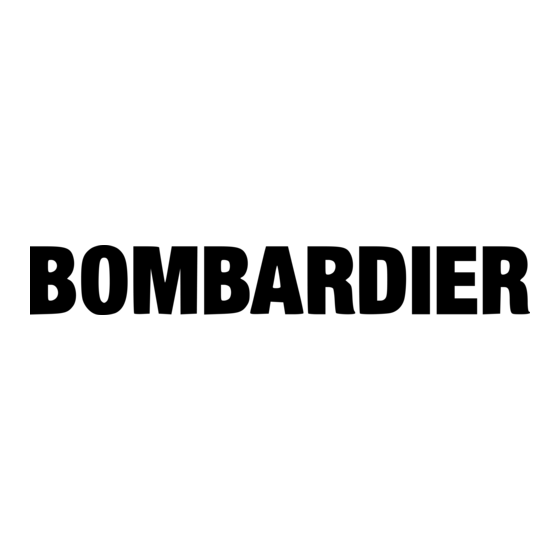

BOMBARDIER SD3-60 Maintenance Manual
Hide thumbs
Also See for SD3-60:
- Maintenance manual (3 pages) ,
- Maintenance manual (102 pages) ,
- Maintenance manual (102 pages)
Advertisement
Quick Links
RUDDER PRIMARY CONTROLS DESCRIPTION & OPERATION
27-21-00
AMM
10.0.0.0
Description
1.
A. General
Refer to Figure
1. Rudder movement is controlled by a system of push/pull rods and levers
which directly connect the rudder bars on the pilots floor with an operating lever on the torque
tube at the bottom of each rudder.
The rudder is provided with a trim tab and an associated control system.
pb1. The tab also acts in a geared capacity i.e. it responds to assist primary surface
movement.
B. Rudder circuit
Refer to 27-21-01,
transmitted via a vertical torque tube which is coupled to the bottom of the left rudder
pedestal assembly.
The torque tube is provided at the bottom with an output lever from which a series of control
rods (inter-connected by lever assemblies positioned as shown) are routed aft below the
main cabin floor, then up the fuselage left sidewall at frame 315.19 and thence through the
roof structure to connect with the rudder operating lever.
C. Rudder stops
The travel range of the rudders is determined by the setting of adjustable primary stops on
each rudder pedestal assembly. When the primary stops take effect, a clearance exists at the
corresponding secondary stop mounted on the torque tube assembly at the bottom of the
rudder.
The adjustable secondary stops are set to contact resilient buffers on brackets fitted to each
vertical stabilizer when the design travel limit beyond that determined by the related primary
stops is reached.
EFFECTIVITY: All
SD3-60 AIRCRAFT MAINTENANCE MANUAL
pb1. Pedal movement on the interconnected rudder pedestals is
Refer to 27-22-00,
27-21-00
z
Page 1
Jun 30/01
Advertisement

Summary of Contents for BOMBARDIER SD3-60
- Page 1 SD3-60 AIRCRAFT MAINTENANCE MANUAL RUDDER PRIMARY CONTROLS DESCRIPTION & OPERATION 27-21-00 10.0.0.0 Description A. General Refer to Figure 1. Rudder movement is controlled by a system of push/pull rods and levers which directly connect the rudder bars on the pilots floor with an operating lever on the torque tube at the bottom of each rudder.
- Page 2 SD3-60 AIRCRAFT MAINTENANCE MANUAL Rudder Primary Controls Figure 1 27-21-00 EFFECTIVITY: All Page 2 Jun 30/01...
- Page 3 SD3-60 AIRCRAFT MAINTENANCE MANUAL RUDDER PRIMARY CONTROLS - MAINTENANCE PRACTICES 27-21-00 11.0.0.0 WHENEVER ANY PART OF THIS SYSTEM IS DISMANTLED, ADJUSTED, REPAIRED WARNING: OR RENEWED, DETAILED INVESTIGATION MUST BE MADE ON COMPLETION TO ENSURE THAT DISTORTION, TOOLS, RAG OR ANY LOOSE ARTICLES OR FOREIGN...
- Page 4 SD3-60 AIRCRAFT MAINTENANCE MANUAL A. Rig the controls Refer to Figure 201 (Sheet Carry out the procedures referenced below with respect to local linkages throughout the system to effect complete rigging of the rudder primary controls. After final adjustment of control rod lengths, check that the rod ends are in safety i.e.
- Page 5 SD3-60 AIRCRAFT MAINTENANCE MANUAL (10) Insert rigging pins R4 and R5 where respectively shown on details E and F. (11) Adjust control rods to suit and reconnect. Rig within fuselage roof (FS351.19 to FS625). (12) Disconnect control rods SD3-45-2108, 2109, 2110, 6078, 6077 and 6080 (see main view) at adjustable ends.
- Page 6 SD3-60 AIRCRAFT MAINTENANCE MANUAL Complete the rigging procedure. (25) Remove travel gauges. (26) Check backlash and circuit friction as detailed in para 3. (27) Select controls LOCKED and check that all rigging pins can be inserted and withdrawn freely. Remove rigging pins.
- Page 7 SD3-60 AIRCRAFT MAINTENANCE MANUAL Rudder Controls - Rigging Figure 201 (Sheet 1) 27-21-00 EFFECTIVITY: All Page 205 Apr 24/03...
- Page 8 SD3-60 AIRCRAFT MAINTENANCE MANUAL Rudder Controls - Rigging Figure 201 (Sheet 2) 27-21-00 EFFECTIVITY: All Page 206 Apr 24/03...
- Page 9 SD3-60 AIRCRAFT MAINTENANCE MANUAL C. Check circuit friction (1) Connect a spring balance to the mid position of a left-hand rudder pedal. (2) Place the pedals in the neutral position. (3) Slowly pull the pedal back through 10° (maintaining the load parallel to the floor and the centreline of the aircraft) and record the maximum load necessary to achieve this travel.








Need help?
Do you have a question about the SD3-60 and is the answer not in the manual?
Questions and answers